#Native American Bead Necklace
Explore tagged Tumblr posts
Text


Recent creations available for sale 🧡 DM to claim!
#art#beaded jewelry#beading#beadwork#earrings#indigenous#jewelry#necklace#native american#carrot#vegetable#wooden beads#vintage
6 notes
·
View notes
Text
One of this most recent things I beaded

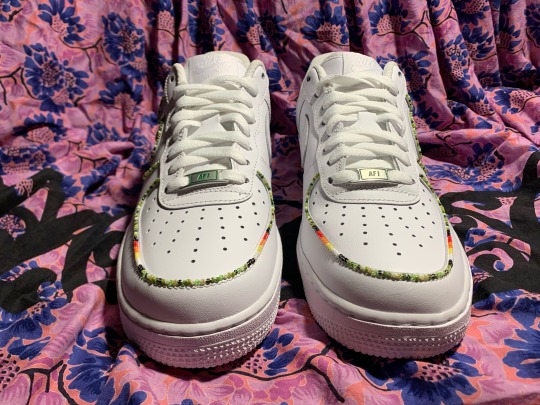


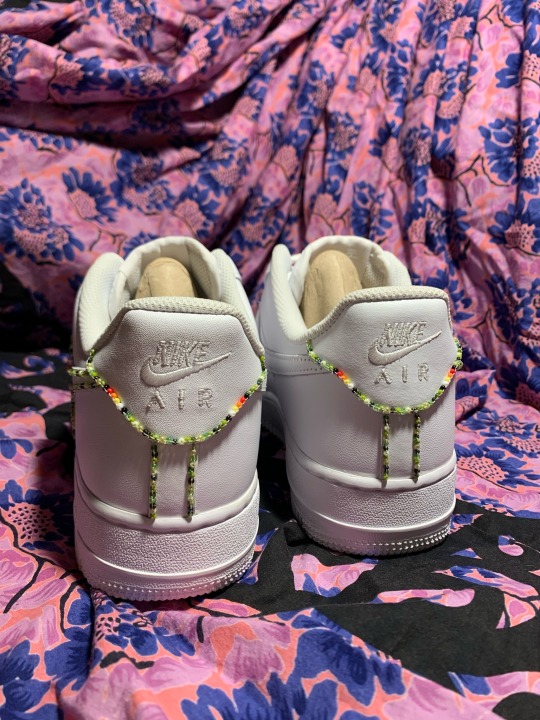

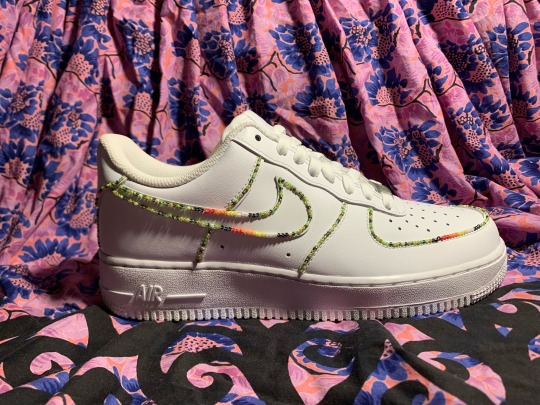

I’m very proud of how these turned out, I love them
#beaded#native american beading#native american art#native art#beaded shoes#Nike#nike sneakers#nike af1#white af1#bead#seed bead#beaded necklace#beaded earrings#beaded accessories#beaded jewelry
5 notes
·
View notes
Text
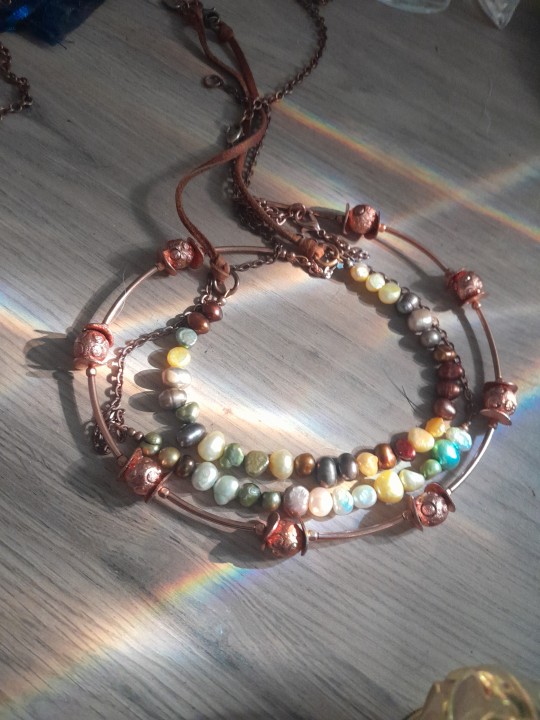
I caught some rainbows
#three sisters#three sisters myth#three sisters pearl necklace#its my specialty#copper and pearls#copper jewelry#jewelry#pearl aesthetic#colored pearls#pearl necklaces#pearl necklace#pearls#pearls and rainbows and copper beads#these are a few of my favorite things#cherokee copper#cherokee#native american#cherokee jewelry#art#copper#maize corn necklace#maize corn pearl necklace#maize#mesmoe speaks
0 notes
Note
I really miss when people used "cultural appropriation" and it had actual meaning. Now it's just used by a bunch of people as a buzzword to try and justify misinformation or trying to white knight.
I'm ESL, first time I heard and had it put into context was about Native Americans, and people selling fake Native American craftsmanship. Eg, it was neither made by a Native, nor did it even use the Native techniques, but it would still be labelled as such. That was the first time, and the solution was to not allow non-Natives to sell anything under the label of Native American craftmanship and that kinda concept. I'm certain the word existed before, but this was the explanation I got, and the one that was repeated for a few years.
Then it became a bunch of people who only read headlines and don't understand the context as to what the cultural appropriation situation was about deciding that you can never wear, do, or create something based on another culture, and if you do that's cultural appropriation. Even if you buy a beaded necklace from a Native artist, you shouldn't wear it because you're not Native, better not even buy it. I remember that one because a Native American designer told people to stop telling people to stop buying from Native sellers and artists. I'm guessing, but I think the designer is "Yellowtail" it's been some years.
Then people had to start explaining the difference and what appropriation actually meant, and why it's important to actually deal with real appropriation, and stop bickering about people wearing things from other cultures that the culture itself freely shares. Eg: Kimonos/Yukatas and don't care if you make your own.
Flash forward, now you have people saying it's an accusation of "cultural appropriation" to tell people not to lie about history. Or is it that it's calling out a POC for lying about history? That still isn't anything that'd count as appropriating, so wouldn't even fall under cultural appropriation, it's just plain lying about history.
--
40 notes
·
View notes
Text
Coronation Dress
So, you may know that for a while now I've been designing the Kingdom of Anchorage and Kodiak, a kingdom in southwest Alaska run by a Native American Orthodox dynasty in a post-apocalyptic world. As part of that, I'm sharing the coronation dress* of its founder figure, Queen Abigail, and looking for opinions from my female followers and other women and girls here.
The base layer is a chemise, and above that are tie-on pockets, a corset (not tightlaced) and the frame for a hoop skirt, covered with a petticoat and a sleeveless smock. All of these cloth layers are made of white silk. For footwear, there are a pair of cream buckskin moccasins covered with blue and turquoise beadwork and with white fur around the tops.
The skirt is layered; the bottom layer is light blue and fringed with beadwork in the shapes of forget-me-nots and northern bluebells, the middle layer is medium blue and fringed with beadwork in the same patterns, while the top layer is dark blue and fringed with beadwork in the shapes of ravens and orcas (respectively very important to the Koyukon people Abigail comes from and the national symbol of Alaska), and alternating raven, snow goose and golden eagle feathers projecting out from the waist, which also has a cloth-of-gold sash tied around it. This layer is also made of silk
The bodice (made of dark blue silk) is decorated with beadwork patterns in the shape of a raven on the right and an orca on the left. It is fastened with buttons at the front, with buttons made of mammoth ivory and carved in the shape of various animals; descending from the top, a raven with spread wings, a leaping orca, a reindeer seen from the side, a standing bear, a moose seen from the side, a leaping salmon and an eagle with spread wings. The shoulders are large and puffed and use sleeve supports, and the arms are wholly covered between them and a pair of bicep-length white gloves made of the leather of young Dall sheep, fastened with mammoth ivory buttons.
The hair is tied back into a bun with a hairnet, and covered with a veil of dark blue silk fringed with gold, worn in the style of a mantilla. A string of pearls are wrapped tightly around the neck, and there is a shell necklace spread over the chest of the same make as this one.
There is also a long dark blue cloak which drapes along the ground, with the monarch's seal sewn into it with gold thread, fastened with silver clasps in the shape of ravens.
Instead of a crown, there is a diadem made of navy fabric, fringed with gold thread; in the centre is the national coat of arms, with the monarch’s seal (both described below) on either side. The diadem is fastened at the back with gold clasps in the shape of bears, with dark blue silken tappets embroidered with the names of family saints in gold thread. From the back and side are strings of circular beads made out of amethyst (directly against the back of the neck), fluorite (on either side of the amethyst beads) and obsidian (against the side of the head).
The coat of arms contains an orca on a Norman-style shield with a dark blue field, with a gold band above and one beneath the orca, and gold around it. Crossed behind it is a harpoon leaning left and a Russian cross leaning right, topped by a raven with spread wings with the Orthodox Christogram above it. The supporters are bears, and the dark green ground beneath it contains forget-me-nots and crowberries.
The monarch's seal consists of a Greek cross, with the corners containing (clockwise from top left) MP ΘΟΥ (the standard Orthodox abbreviation of "Mother of God"), IC XC (the standard Orthodox abbreviation of "Jesus Christ"), a ligature of βδλ (the consonants of basileia, "kingdom") above AK (Anchorage and Kodiak) and AL LD (Abigail's initials; her surname is Littlefield).
Tagging @femme-et-traditionnelle, @miss-rogers-all-american, @melisssg99, @luvchristxx and @roses-red-and-pink for your opinions! Particularly if anyone has the time, skill and inclination to draw it, please do so!
*While made for the coronation, she still wears it at other extremely formal events, namely Pascha and the final dinner of potlaches.
12 notes
·
View notes
Text
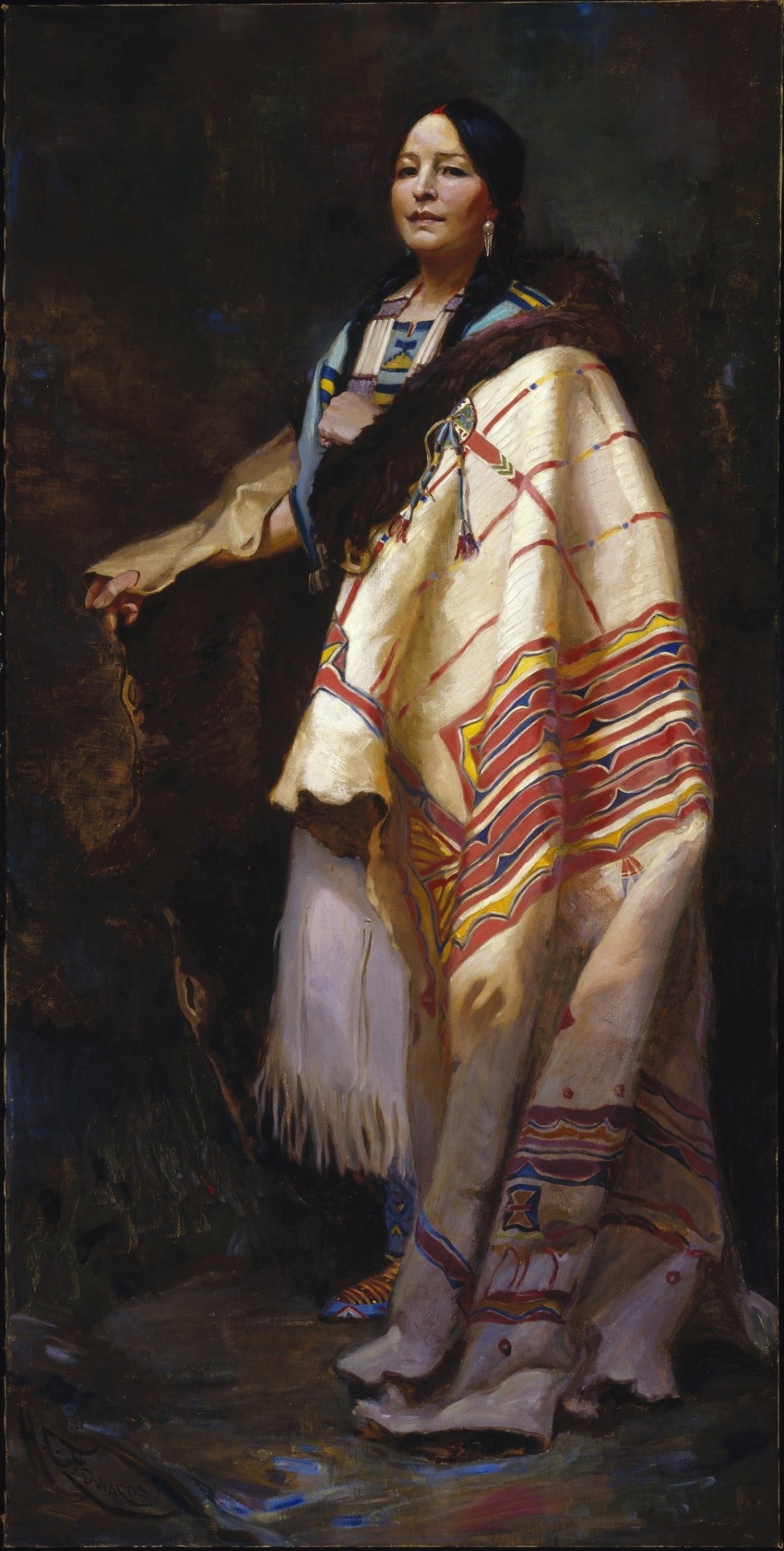
Harry C. Edwards - Handsome Morning -- A Dakota (1921)
Harry C. Edwards’s striking studio portrait of Handsome Morning—a woman the artist identifies as Dakota Sioux—reflects a turn-of-the-century fascination with romanticized subjects in costume. Handsome Morning’s regalia consists of a fringed dress with beaded yoke, a tubular bone-bead necklace, beaded moccasins, and a buffalo-hide robe. It is likely that she was styled and posed according to conventional portrayals of Native American people made popular by the theatricalized portraits of photographer Edward S. Curtis, which included the mixing of tribal dress and ornamentation, and the use of stoic expressions and gestures.
Akin to the 1880 U.S. government–commissioned Crow Peace Delegation portraits, which were later appropriated and annotated by contemporary artist Wendy Red Star. Edwards’s use of his sitter’s name in the title signaled authenticity to viewers. Artists at the time were aware of the U.S. government’s long-standing exploitation of, and open assault on, the lives and lands of Native people. Edwards was likely motivated by an interest in his subject as a curiosity rather than by an active regard for her community. (source)
125 notes
·
View notes
Note
Do you mind sharing some of those shops, so our pals can dress their ocs without risking cultural appropiation for the new twst event? Thanks and if you don't want to, it's fine 🤝
Hi, thanks for the ask! First off I would like to clarify that I am local but not native, meaning I grew up in Hawaii but am not indigenous Hawaiian, so I can answer this but not as any kind of major authority on Hawaiian appropriation. Just to be transparent about your source here. (Also keep in mind I grew up on one single island, and the culture varies somewhat from island to island)
I can list some shops, but if you're worried about appropriation it's important to know that you'll find the most offensive and appropriative stuff in tourist shops, so I'm gonna start with a short list of things you'll find and should avoid first:
•Tiki shit. -These are actually an important Hawaiian tradition tied into the religion that has been exploited all to shit. There's still some casual or ironic use of tiki aesthetics by locals, but it's better as a visitor to just not. (There's a kinda Okay and Not Okay division of this, and you can tell by context and artstyle and shit, but I don't know how to reliably describe it)
•Hula paraphernalia. -Coconut bras are a costume, they've never been a real Hawaiian thing, they're literally just some bullshit aesthetic made up by and for haoles. Grass skirts are very occasionally used in hula, but not even a common material for hula skirts in the first place. But also, hula is a very important aspect of Hawaiian culture that should not be used as a costume in any form anyway. This includes haku leis (different from the classic flower lei, flower leis are ok), and any hula instruments (Ipu gourds and basically anything with red and/or yellow feathers, for a start). (Also, jokingly 'doing the hula'? Obnoxious.)
•Traditional Hawaiian tattoo art. -First off this is different from other ancient Hawaiian art (which can be its own gray area, but less dicey), traditional tattoos are very deeply important and have specific meanings, often related to ancestry and aumakua (think like, ancestral spirit animals). There is a lot of nuance here, and there is some stuff stylized off of traditional art that's widely sold, but again it's a nuance that I cannot easily convey and it's safer to just not do it.
•Hawaiian warrior paraphernalia. -If you ever go to Hawaii, you'll see a lot of charms and necklaces and graphic prints of Hawaiian warrior helmets, Hawaiian warriors, and boar tusk charms, Just Don't with these.
Also, special note on Luau: Tourist "luaus" are a very common attraction, and a likely event for tourists to go to. They are also immensely exploitative, white-owned, and culturally insensitive.
Anyway, clothing: It's good to remember that Hawaii is a US state, and we actually have a lot of the same brands and stores as the mainland united states (though living in the mainland, I've come to realize that the stuff we have is mostly west coast brands/companies) and we mostly wear a lot of common american clothing. So your OC would have access to a lot of common american clothes + aloha wear. The easiest way to avoid looking like a dick is really for the OC to mostly wear stuff familiar to them but suitable for very humid weather in the 75-95°f range, and whatever kind of beachwear they'd prefer. As you can see with the twst boys, they're actually mostly wearing beachwear or chino pants (which are a typical tourist choice, not a local style) and aloha shirts (a style developed in Hawaii through a mix of cultural influence and immediately marketed to the mainland by the creators, so not sacred and totally okay to wear), accented with straw hats, flowers, and a lot of beaded jewelry commonly sold but not culturally significant.
[Casual clothing]
We mostly wear shit like jeans/shorts/boardshorts and tshirts/tanktops/hoodies depending on the weather. It's common in Hawaii to wear beach clothes all over the place, like boardshorts and bathing suit tops/shirtless outside, and throwing on a tank top or tshirt indoors or more public areas like the mall. And most footwear is slippers (flipflops), closed shoes are worn but not as common for casual day to day. In general locals just, aren't as weird about exposed skin and the existence of feet as a lot of westers cultures? Like bare feet and sandals are normal, short shorts/crop tops/bikinis/shirtless guys aren't something to ogle at, they're just everywhere. Same with tattoos.
Some common local brands/local favorites: -Maui Built -Hurly -Quicksilver/Roxy -Local Motion -Billabong -Skate brands like Zumies are also pretty popular -American Eagle is really popular specifically with gay guys and christian girls, do with that info what you will
-You'll find a lot of popular tourist stuff like straw hats, souvenir beach towels, souvenir jewelry, and aloha print accessories at places like ross and walmart, as well as tourist centric shops like abc stores and whaler's village. With the exception of the problematic shit I listed, these things are typically inoffensive, but can be tacky. Basically you would be immediately clocked as a tourist, but you're not doing harm.
-Aloha shirts are sold in most clothing shops, and come in various levels of quality and formality. Higher end aloha shirts come in silk or imitation fabrics, relatively thick woven, are well fitted, and usually have less loud patterns (think Azul's shirt), and can be considered formal or business wear. These are something that would be appropriate in any office, weddings, fancy dinners, shit like that. More causal aloha shirts tend to be boxier cut and lighter fabrics like cotton, they have louder patterns and are often worn untucked or open over a tanktop/tshirt/bare chest (like Jack, Ace, Lilia and Floyd).
-Floral print dresses in light fabrics and various styles are really common for women, and often worn by tourists. These are usually longer, like at or past the knee but not floor length. The top worn by Riddle and the way it's styled is a woman's fashion mostly worn by tourists and haole women who moved to the islands. I can't remember seeing any local girls wearing these, but that doesn't mean it doesn't happen.
[Accessories]
-Hats: Straw hats are usually worn by tourists, though some locals will wear them too (usually women at the beach, most men I've met will wear them ironically if they do at all. But ironic/satirical fashion choices are very common and get incorporated into outfits all the time). Women's hats are round with wide flat brims (Lilia, Riddle), mens are usually more fedora shaped (Ace). Floyd's looks like it's a pork pie panama hat, which is one of the most expensive hats you'll find, and referential to old timey gangsters, especially with the white shorts and aloha shirt combo. (I used to work in a hat shop sorry). Anyway most locals will wear flat brim baseball caps made of thick cotton with no mesh. Some people wear the curved brim mesh ones, but they're usually older people or white.
-Jewelry: This varies a lot, there's a few really common things that you see all the time, and the rest is usually combinations of Japanese and American fashions incorporated to individual tastes. Tourists almost never wear local jewelry styles and most jewelry worn there is a mix of modern Japanese and American styles that vary widely by individual preference. Tourist jewelry tends to be high end gold and silver stuff with Hawaiian themed motifs like sea creatures (turtles and whale tails being the most popular, then tropical fish, sharks, and octopus), tropical plants (hibiscus, plumeria, monstera leaf, bird of paradise), pearls (especially Tahitian black pearls), and mother of pearl or abalone pendants/earrings. And on the cheaper end there's the kind of wood bead and simple cord + charm bracelets (Jack) and shells or shaped clay beads (Riddle, Lilia), simple cord necklaces with shark teeth or metal charms (surfboards, sea animals, the like) and sometimes clay or steel beads, cheaper pearl necklaces, and toe rings. Things to avoid would be any motifs with warrior helmets, gourds/feathers, tribal print, and tikis. Bone or steel fish hook pendants are very popular with local men, and I personally find it weird to see on tourists because it feels very much cultural, but I haven't actually heard complaints on it, so I'd love it if anyone else wants to weigh in
-Side note on Ace just because I find it interesting: His braided leather belts and bracelets are actually referential to a popular style up the mountains that comes from the Paniolos, Hawaiian cowboys originating from Spanish influence who predated the cowboys of the classic American West! It started out as simple Spanish style plaited leather belts, then spiked in popularity in the 70's as part of a western clothing trend that still remains in fashion leather goods today. Hawaii still has some cattle ranches and historic cowboy towns with the original storefronts and everything.
-Pareos/sarongs are popular bathing suit accessories and I haven't heard anything about it being an issue. Again, avoid the problematic motifs listed earlier to be on the safe side.
-Sunglasses are a free for all, I buy all mine at ross but the popular brands I mentioned usually have their own lines. I see thick black brims (think oakleys) most often with locals, aviators are less popular. Oakley and Ray Ban are probably the most popular high end brands for locals?
-Footwear: As I mentioned earlier, most footwear is open toed slippers, these come in a variety of styles like the classic rubber slipper, sturdy foam ones like Scotts brand (a lot of these have bottle openers in the sole these days), and fancy leather ones like Olukais that can be worn with nice clothes. Also my personal favorite are the platform foam slippers which range from 1-6 inches in height that a lot of local girls wear. People wear closed shoes/boots about the same way the rest of america does I think, just less often? This includes dress shoes and heels for fancy settings. Popular closed shoes for locals are skate shoes and canvas chucks, I don't know if puffy hightop sneakers are still a thing anymore. Tourists often wear boat shoes(?) and similar kinda low cut light material styles.
-Leis and flowers: People gift leis for celebrations like graduations and weddings, sometimes greetings after long trips, but nobody wears flower leis as a casual style. Some men (usually in sales and guest services will wear kukui nut leis as part of their business attire, but it's not streetwear. There are also specific lei for hula that you just shouldn't wear. If you wanna put your OC in a lei go for floral, the most common tourist leis are purple orchids. Women will often wear flowers behind their ears of they feel like it, pretty much any variety. They also sell these foam-clay plumeria flowers on bendable wire stems in a variety of colors to wear behind the ear which are a fairly common accessory and super cute imo. Aside from that, people don't wear flowers often, the piles of flowers on their hats and shoulders in the promo art is not really a thing in Hawaii, like at all? And definitely not fruit. Nobody wears fucking bananas and mangoes, Ace looks like a clown.
-Important note on that though! The belts, bead necklaces, and floral shoulder things may potentially be referential to other pacific island cultures that I am not familiar with. I'd encourage you to do more research on those, as they may very well be appropriative (again, I don't recognize them and cannot say one way or another. I don't even know for sure about the fruit). I'd start with checking Tongan, Samoan, Filipino, Okinawan, and Indonesian traditional clothing to start with.
[Rich people clothing]
This is something that I don't have much experience with because I'm not rich, and tbh most locals aren't either. There's a massive wealth inequality issue in Hawaii, so there's a million high end restaurants and clothing stores and jewelers, but they're mostly exclusive to rich tourists, the people who can afford to move and buy land there, and their kids who are typically kept separate from the rest of the community.
-The popular Hawaiian Jewelry brands I know of are Na Hoku and Maui Diver's Jewelry. But in general I think the best source I can recommend is to check out the Shops at Wailea website and see what brands and styles they offer.
Aaand that's all I have energy for, I hope it's helpful. If any other Hawaii locals wanna add on that'd be awesome!
#anon ask#asks#twst hawaii event#twst stitch event#lost in the book with stitch#twsited wonderland#twisted wonderland lost in the book with stitch#twst lilo and stitch
30 notes
·
View notes
Text
General mystery items/collections ideas for my dream Riordanverse unboxings
Weapons
Pins (and an armory themed pinboard or hanging)
Charms to go along with their hiding place (like a charm at the end of a pen for riptide or on a rune pendant for Jack/Sumarbrandr or on a bracelet for Serwa’s blade)
Stickers (and an armory themed sticker book)
Pens
Gods
Playing cards - 14 god cards for each pantheon to correspond with 2-10, J, Q, K, A and a joker/trickster card. And ideally similar gods would be in similar places, so Zeus and Odin might both be kings. Collecting four pantheons would allow you to play any regular 1 deck card game, but maybe having pantheons from similar areas (Greece and Rome, Mayan and Native American, Egyptian and Ghanaian, etc) be the same color would allow for mixing and matching or games where two decks are used, like five crowns. Or could play games like UNO. I once made a game like this for a camp I taught, so this one is close to my heart.
Trading cards with stats for a mythomagic type game across the pantheons
Pins (characters, or cabin sets representing each, or chariot or car, or train car representing them and their power)
Stationary set with quotes
Themed socks (this might be the part of me that wanted to make sock monkeys for each camp halfblood cabin)
Dice sets (Artemis dice on tic tok was doing a Norse mythology one as I was reading Magnus Chase)
Monsters/Enemies
Lenticular cards (many of them morph somehow with the mist)
Trading cards with stats for a mythomagic type game across the pantheons
Stickers! Or magnets/pins.
Tshirts of locations they work (monster donut!)
Plushies
Replicas
Coins (golden drachma, Mayan death/jaguar coin, etc)
Quest items
Prints
Blueprints of important locations
Maps
Family photos/friend or quest group photos in family portrait mode
‘Photos’ from locations or moments between combat
Menus from food places
Report cards or detention slips
Wanted posters
Scrapbook pages (to go with the prints, make your own demigod scrapbook - my inner middle schooler would have gone nuts to use this as a way to do a book reports - note to self, reading notebooks with book report type prompts!)
Lists of chapter titles
Demigods
Wanted poster pins or sticker sets
Pins with themes
Stickers with themes (I saw an awesome sticker set that had what each quest member had packed for a quest)
Famous quotes on bookmarks
Famous quotes as stickers
Detention slip notepads
Their own playing cards or trading cards with stats
Camps/training locations
Tshirts (beyond the usual camp halfblood/Jupiter, I also enjoy seeing the ones like Delphi strawberry farms!)
Lanyards
Maps
Other wearables, like backpacks/hats
Beads for a growing beaded necklace collection
Important locations/realms
Stickers and a 9-realms passport sticker book!
Fairy doors
Keys
Potions or potion ingredients
Runes as stickers (decorated with their meaning somehow)
Puzzles
Mugs or cups
#percy jackson#rick riordan presents#rick riordan#riordanverse#riordan universe#read riordan#heroes of olympus#trials of apollo#kane chronicles#magnus chase#aru shah#Zane obispo#stormrunner#mythology#Sal and Gabi#dragon pearl#Paola Santiago
39 notes
·
View notes
Text


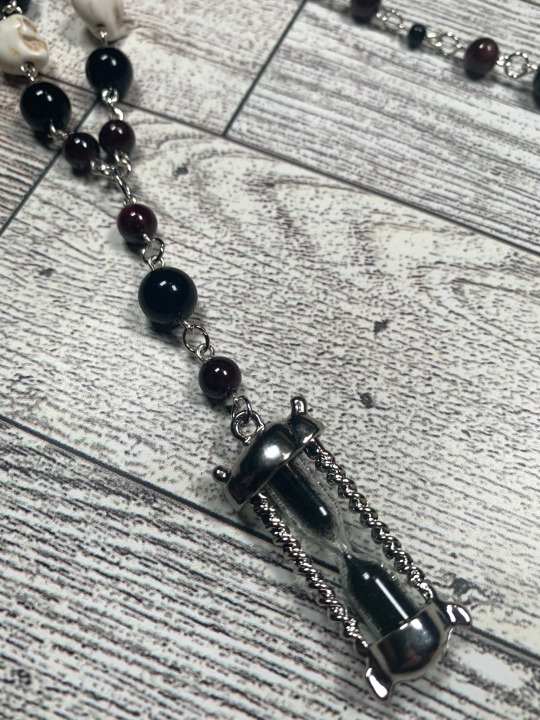
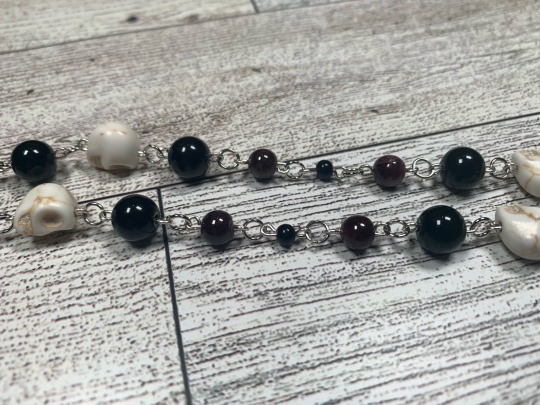
This necklace is hand made with death and time in mind this piece is inspired by Greek God Thanatos and the Norse Goddess Hel. This Prayer Beads has a semi Hour Glass pendant that is timed at only a few seconds. This necklace is also inspired by the Angel of Death Azrael. This piece is made with Garnet, Onyx and Howlite and tarnish resistant wire, resistant not proof so please keep in mind when cleaning.
This piece is long enough to slip over your head, no clasp needed but I can add one if you want, please message me right after purchase or leave it in notes.
While support my small business you also support other small businesses which I buy from. This includes a local Native American bead vendor and an elder mom and pops shop. Thank you so much for choosing my designs.
#death goddess#chthonic#death gods#hades devotee#hades devotion#thanatos#thanatos deity#hel deity#king hades#queen persephone#hekate goddess#hekate devotee#underworld goddess#hour glass#skull jewelry#witchblr#witchcraft#witchythings#paganism#witch crafts#prayer beads#crystal necklace#hellenic polytheism#norse pagan#norse pagan witch#the fates#gothic jewelry#gothic fashion#pagan rosary#pagan prayer beads
101 notes
·
View notes
Text








Beading palettes pt. 1
#beading#indigenous#beadwork#jewelry#beaded jewelry#vh creative#necklace#earrings#native american#native alaskan#queer creator#art
3 notes
·
View notes
Text
Here the first couple of things I taught myself to bead.

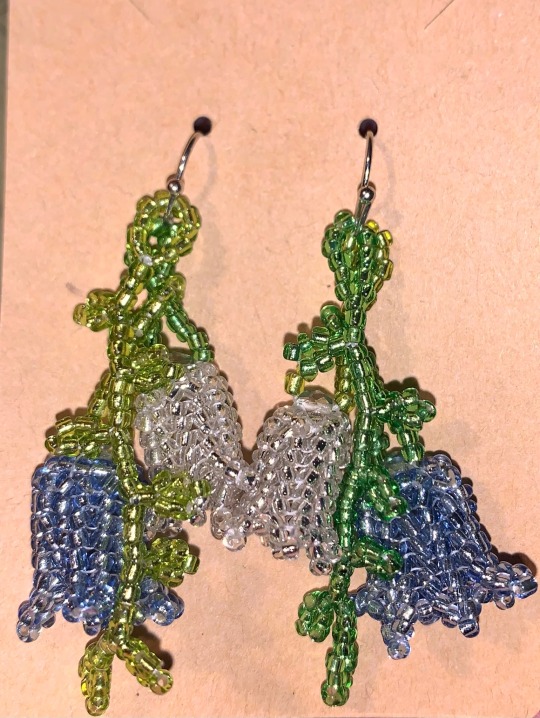

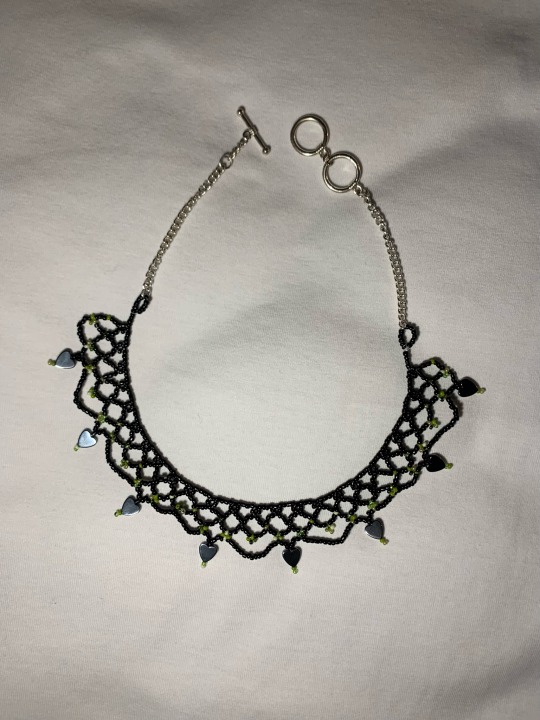
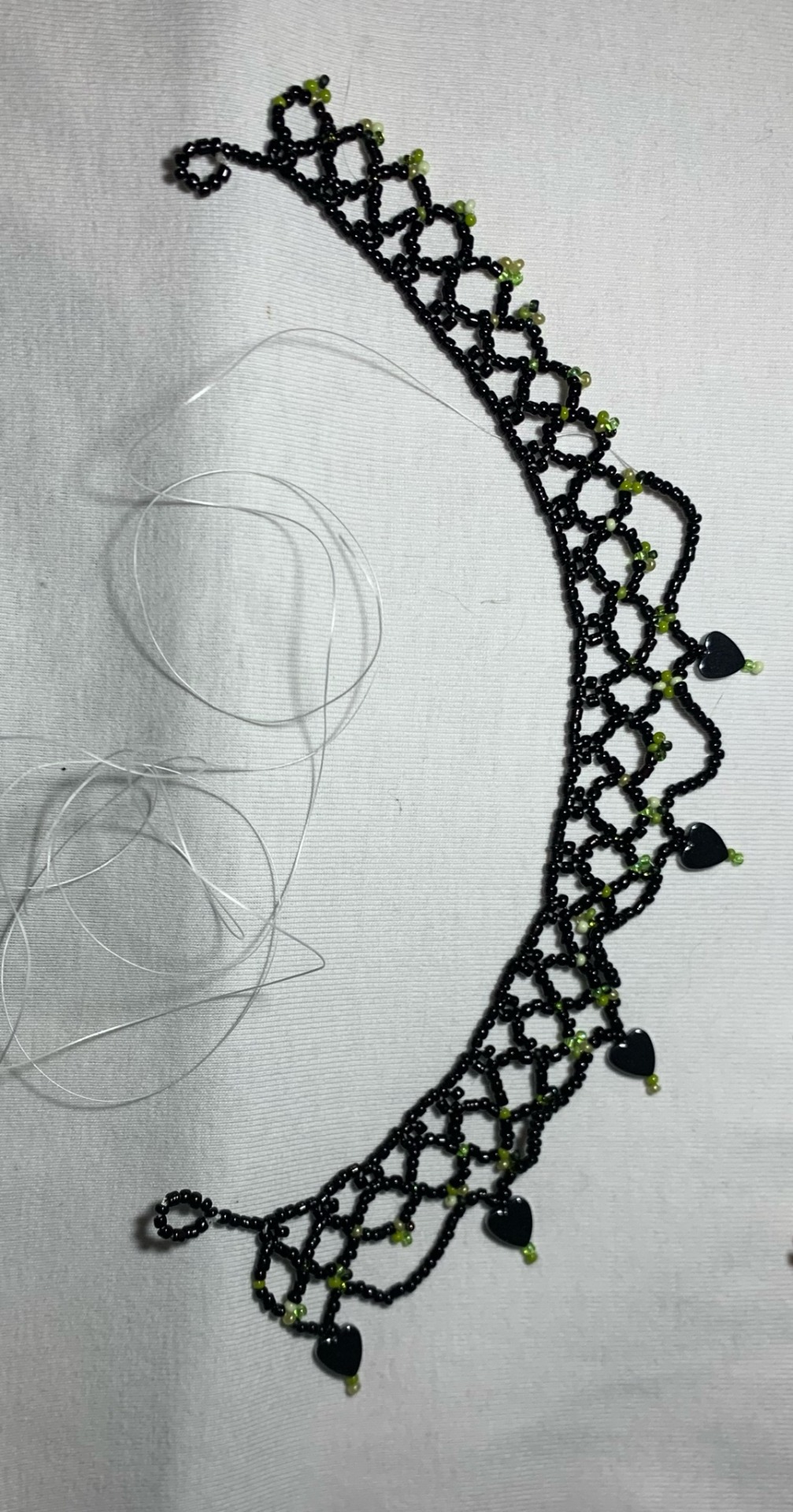



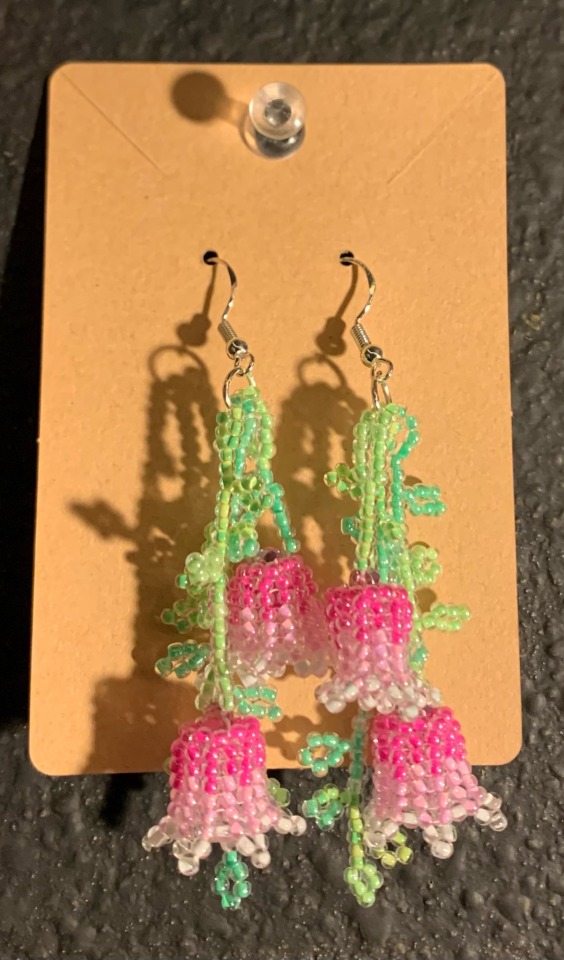
#seed bead#Native American art#Native American beading#bead#beading#handmade#handmade jewelry#bell flowers#mushroom#mushroom jewelry#beaded necklace#beaded earrings
4 notes
·
View notes
Text

Black Foot, Standing Bear, Big Eagle
Denver Public Library Special Collections
Creator : Rinehart, F. A. (Frank A.)
Date : 1898
Three Native American (Sioux) men, identified as Black Foot, Standing Bear, and Big Eagle pose near tepees ... Black Foot and Big Eagle are facing, Standing Bear is in profile. Each man holds a rifle next to him ... Black Foot wears moccasins, leggings, a breech cloth, an animal hide vest decorated with disks, a necklace, glasses, and a headdress ...Standing Bear wears beaded moccasins, leggings, a fringed and beaded shirt, and an ornate headdress ... Big Eagle wears moccasins, leggings, a print shirt, a hair pipe breastplate, eagle feathers in his hair, and holds a fur covered staff in his other hand ... Trans-Mississippi Exposition and Indian Congress, Omaha, Nebraska ... Dakota Indians--Clothing and dress; Indians of North America; Tipis; Big Eagle; Black Foot; Standing Bear, Luther, 1868 ...
54 notes
·
View notes
Text
Horses: Inupiat
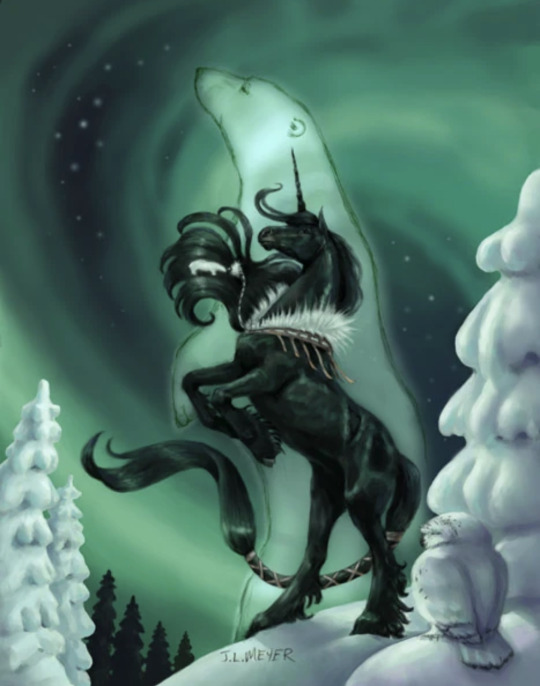
Inupiat is an adult male unicorn. He is officially part of herd Mustang. His animal friend is a polar bear. Inupiat was created by Jennifer L. Meyer.
Inupiat is a pure black stallion. His coat, hooves, mane, tail, and horn are entirely black. He has a long mane and tail with a long horn and feathering around his hooves. Part of his tail is bound by a brown/grey strap and he wears a brown harness around his neck with white feathering and beads.
Inupiat is named after the Inuit people, a tribe found in Northwest Alaska and the Bearing Strait. The name “Inuit” means “real people”.

Like most others Inupiat’s stable art follows the original art well even having a slight green shade on parts of him despite the fact under different lighting this shade would not appear. Inupiat had a regular stable which uses the Native Lights card art for the portrait.


Quote: “You have the strength and spirit to face any challenge”
Inupiat makes 2 appearances in the card series. He appears in Native Lights as a promo card in the North American release and as a base set card in the International release. Inupiat appears again in the Best of Bella Sara series using the same card art.
Bellow is the magazine Inupiat could be found in.
(This is such a mid 2000s girl magazine. The headband, side ponytails, flower necklaces. The magazine telling you how to be more likable and the girl advice. Not to mention the quizzes and best friends theming)
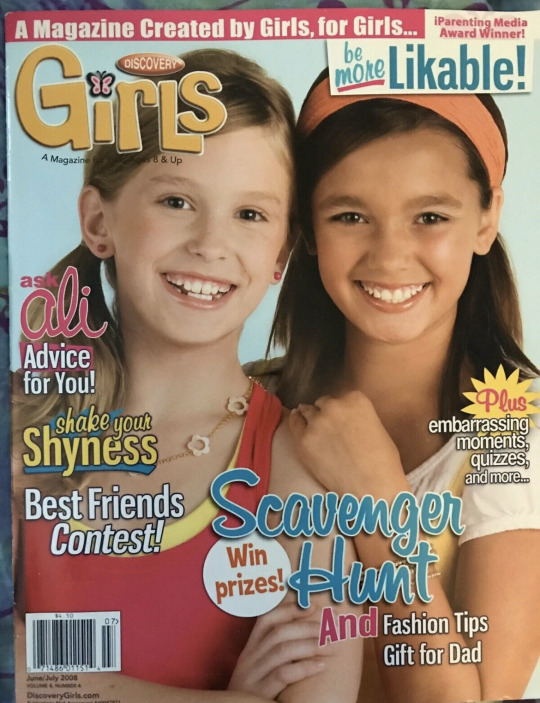
Other appearances:


Inupiat appears as a mini figurine for series 1 and appears in the Bellapedia.
Opinions: Inupiat makes the top 10 as one of my favorite horses. Jennifer L. Meyer makes such gorgeous horses especially unicorns. His beautiful figure coupled with the pure black is amazing. Pure unicorns are already not super common in the Bella Sara world so Inupiat being the only pure black makes him even more special.
Headcannons:
- Like the rest of hers Mustang he does not stay in one area.
- He however typically sticks to colder areas.
- He loves to travel around and help people always reassuring them that they are strong.
- He is huge
- He himself is very strong both physically and spiritually as well as magically.
- He has been invited to herd Bellasara but declined to stay with Mustang.
- His magic can summon the spirit of a polar bear and can even control the lights in the sky
- He is well known throughout all of North of North
- Some consider him a myth for how quickly he appears and disappears.
#bella sara#bellasara#horse#fantasyhorses#horses#magical horses#fantasyhorse#2000s nostalgia#herd Mustang#unicorn#black unicorn#Inupiat#Jennifer L Meyer
49 notes
·
View notes
Text

Labradorite aesthetic moodboard!!
Labradorite:
Appearance: Labradorite presents an ethereal and dignified presence, embodying both the mysticism and strength of her heritage. Her entire coloration features a shimmering silver undertone, interwoven with vivid iridescent flashes of red, blue, green, and yellow. This radiant interplay of colors gives her an almost otherworldly appearance, as if she is perpetually bathed in the light of a sunrise or sunset.
Her gemstone, a trapeze-cut jewel, is elegantly placed on her right ankle, glowing with a spectrum of colors that mirror the natural beauty of her iridescent skin. Labradorite's eyes are a striking blend of colors that shift with her emotions, reflecting the deep connection she has with the world around her.
Attire: Labradorite's attire is a harmonious blend of traditional Native American clothing, crafted to reflect her unique coloration. She wears a beautifully beaded dress made from soft, silver-toned leather that shimmers with her iridescence. The dress is adorned with intricate patterns and symbols in red, blue, green, and yellow beads, each design telling a story or holding significant meaning.
Her accessories include a wide, beaded belt that cinches her waist, and matching moccasins that also reflect the iridescent colors of her gemstone. Labradorite wears a headdress adorned with feathers that mirror her multicolored iridescence, each feather representing different aspects of her heritage and spiritual beliefs. Around her neck, she wears a necklace of polished stones and beads, each one carefully selected for its symbolic meaning.
Personality: Labradorite is known for her calm and reflective nature. She is deeply connected to her culture and traditions, carrying herself with a quiet strength and wisdom that commands respect. Her personality is marked by a deep sense of empathy and understanding, allowing her to connect with others on a profound level.
She values harmony and balance, both within herself and in her interactions with the world. Labradorite is often sought out for her counsel and insight, as she has a unique ability to see the interconnectedness of all things. Her iridescent nature symbolizes her multifaceted personality and her ability to adapt and reflect the beauty of the world around her.
2 notes
·
View notes
Photo
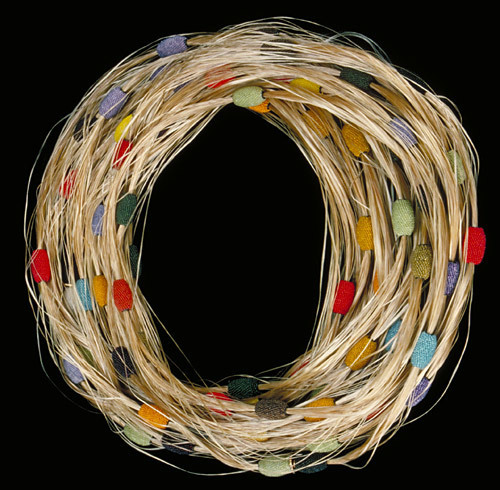
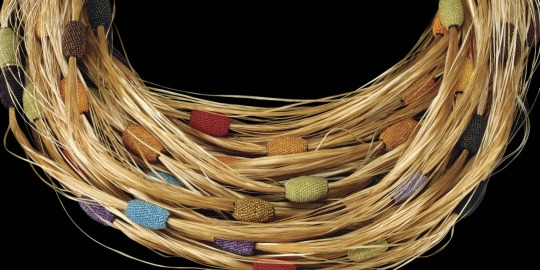


A necklace of yellow-colored material with solid colored beats throughout the necklace
Jacqueline Irène Lillie (French, b. 1941)
Austria, Vienna, 1992
Glass filaments, glass beads, knotted silk
Diam: 28.8 cm92.3.47, 7th Rakow Commission
Internationally recognized for her innovative, sculptural work in beads and mixed media, Jacqueline Lillie is the first artist to receive a Rakow Commission for jewelry.Originally inspired by the early 20th century jewelry produced by the Wiener Werkstätte (Vienna Workshops), Lillie’s interests have expanded to include African and native American jewelry, Russian Constructivist painting and graphics, Art Deco design, and the wide-ranging products of the Bauhaus. Her intention, she says, is not to revive earlier styles but to “produce work that reflects attention to minute detail and a subtle use of color.
”Lillie’s jewelry often takes the form of neckpieces or brooches constructed of single or multiple beaded spheres, ovals, and squares that she combines with metal. She also makes beaded bracelets and other articles of adornment. Her beading is characteristically tightly woven, usually in geometric patterns.
The Rakow Commission neckpiece is an unusual work for her in that she combines two distinctly different types of glass products: fiberglass monofilament and glass seed beads. The layers of glass fibers and multicolored beads are reminiscent of the lengths of trade beads strung on raffia palm fibers that are commonly found in West Africa. Yet, her necklace is a contemporary statement that emphasizes the versatility of glass, a material both traditional and modern.
https://info.cmog.org/rakow.../jacqueline-irene-lillie
11 notes
·
View notes
Text

The feminine energy of spiders reminds us that we have the ability to weave our lives into strong beautiful works of art.
We may not realize that the sight of a spider’s web glistening in the sun, the beads of morning dew catching the light to shine like diamonds on an intricate necklace, may carry a message for us. Their beauty belies their strength because though they are spun from thin strands of silk, they can hold the weight of the dew and capture nourishment in their nets as well. This paints an accurate picture of the traits of the weaver, the spider. Their feminine energy reminds us that we have the ability to weave our lives into strong, useful, and beautiful works of art. Though people may have an instinctive fear response to spiders, we can look beyond the physical instinct to understand the spiritual message they may be bringing us.
Among the various Native American traditions, spider medicine has been known to represent creativity. Her eight legs represent the four winds of change and the four directions on the medicine wheel, while her body is in the shape of the infinity symbol, which represents infinite possibilities. Spider was said to have woven the alphabet, creating the means for people to communicate and record their history through language. Just like the Greek myth of the Fates, three women who weave the tapestry of life, spiders are said to weave the creative forces that bring forth the intricately symmetrical patterns of our lives.
So if a spider has wandered into your line of sight, she may be bringing you one of several messages. She could be reminding you of the infinite possibilities you can draw from to create your life. Perhaps her message is to check your email or “the Web” to see if communication you sent has captured something. You might even want to refer to old journals to look for patterns recorded in your personal history. As spider weaves her web, you too can weave your reality and your future. Her medicine could be reminding you that as the creator of your life you need to have the courage to reach out and create your own intricately beautiful and strong tomorrows. If you don’t pay attention, spider may feel the need to bite you to get your attention. If this happens, investigate what that part of the body represents to gain further information about your message from spider medicine.
2 notes
·
View notes